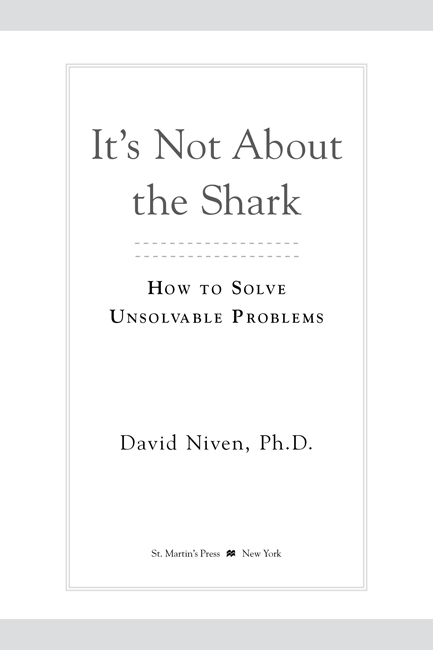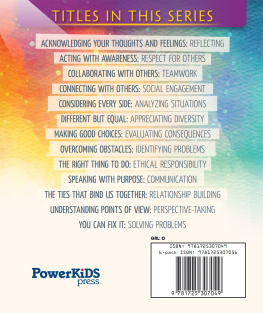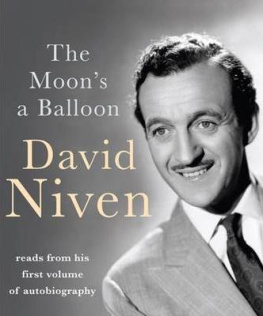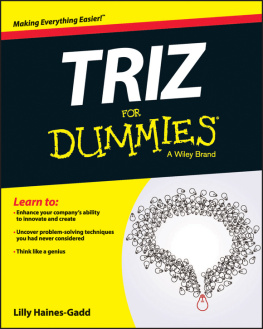Contents
Guide

The author and publisher have provided this e-book to you for your personal use only. You may not make this e-book publicly available in any way. Copyright infringement is against the law. If you believe the copy of this e-book you are reading infringes on the authors copyright, please notify the publisher at: us.macmillanusa.com/piracy.
To Tina and Katie
C ONTENTS
I NTRODUCTION
Problem or Godsend?
T HE PRESSURE ON the young director was unrelenting.
He had burned through the studios money and exhausted their patience.
After shooting was finished each day, the knot in his stomach grew tighter and tighter as he screened the new footage with his team. Sometimes they would watch an entire days work without finding anything that could be used. Frankly, the more we saw, the more we worried, recalled Bill Butler, the films cinematographer. We had a problem .
It wasnt hard to identify the crux of the matter. The films star, playing the title character, was simply impossible to work with. Complicating matters, the usual inducementsmoney, flattery, obsequious attention to his comforthad no effect whatsoever on the films fickle lead.
So day after day, Steven Spielberg sat in the dark, watching another reel of another days wasted footage. He was directing his first movie for a major studio. He had already heard the whispers of doubts from studio executives, worried that he was in over his head. He had already overspent his films entire original budget on one prop. He was rapidly becoming convinced this would not only be his first film but his last.
More to the point, though, he had to face the reality that the mechanical shark he had cast in a starring role in his film Jaws, a shark he imagined haunting moviegoers dreams as some kind of Godzilla of the sea, couldnt swim, couldnt bite, couldnt even tread water.
It was not for lack of effort. The sharknicknamed Bruce in honor of Spielbergs lawyerwas a phenomenally complicated pneumatically powered colossus, attached to 150 feet of hose linking it to compressors floating above, on a barge. It took a small army of peopleeach working a different lever that controlled a fin, or the eyes, or the mouthto make it go. It had been designed by the most experienced talent in the industrypeople credited with creating the giant squid in 20,000 Leagues Under the Sea and some of the most frightening sea creatures ever to appear on film.
But, to an almost comic degree, the shark was a failure. Originally tested in a freshwater tank in California, the shark was shipped to the Massachusetts coastal town where the movie was to be made. There, the filmmakers received a crash lesson on the uniquely corrosive effects of salt water. As its controls shorted out, the shark would move or not move without the slightest interest in who was pulling which lever. Every day there was something else that needed to be repaired, replaced, or re-welded because it didnt work or had been damaged during filming on the rare days the shark had been functioning while the cameras were on. Even its synthetic skin failed, as it became waterlogged and bloated, transforming the terrifying shark into a giant sea marshmallow.
It kept failing and failing and failing and failing, said Bill Gilmore, one of the films producers. Richard Dreyfuss, who played an oceanographer in the film, vividly remembers getting into position to start shooting a scene, only to hear the relentless squawking of the crews walkie-talkies and the alarmed words that rang out from them repeatedly: The shark is not working The shark is not working.
Even on its best day the shark was loud and slow. You could get out of the water, dry off, and eat a sandwich before it could get you, said Jaws cameraman Michael Chapman.
Millions of dollars, months of time, the best technical experts they could find, and what Steven Spielberg had was a rapidly closing window to make a movie about a shark and no shark.
With a broken-down great white shark on his hands, Spielberg had a great big problem and several unattractive options. He could put all available resources into repairing the sharkand almost certainly see his unfinished movie shut down when he ran out of money and time. He could ditch the failing shark and start from scratch, building a new version designed to overcome the first models limitationsand almost certainly never gain the green light to resume filming. He could forge ahead with the malfunctioning shark, employing translucent wires or whatever tools he could improvise to make it moveand get the film shut down, get himself fired, or make a laughably bad movie, consigning his film and his future to the realm of Attack of the 50 Foot Woman and other movies remembered only for being embarrassingly bad.
This is a book about what we do when we have a problem. And research shows that what we do most of the time is crawl deep inside our problems. We define everything on the problems terms. We limit what we think is possible based on the boundaries the problems set for us. We look at the problems every which way, only to conclude that every available response produces alternate forms of failure. Like staring at the sun and not being able to see the sky all around it, we stare at our problems and cannot see anything else, much less a solution.
Steven Spielberg did not stare at his problem.
Despite the fact that the script began with a close-up view of the shark attacking a swimmer, and despite the fact that the shark was featured all over his storyboards throughout the movie, Spielberg took the failure of his mechanical shark as an opportunity to reimagine what he was doing. He didnt think of ways to tinker with the broken shark or plead for more time and money that would not have been offeredinstead, he flipped the situation on its head.
I thought, What would Alfred Hitchcock do in a situation like this? Spielberg explained. So, imagining a Hitchcock movie instead of a Godzilla movie, I got the idea that we could make a lot of hay out of the horizon line, and not being able to see your feet, not being able to see anything below the waistline when youre treading water. Whats down there? Its what we dont see which is really, truly frightening.
From that thought he saw the solution: Make a shark movie without the shark .
Spielberg supplied the suggestion of the sharkin the sight line half above and half below the water, in the ominous and unforgettable John Williams score (which he described as the sound of unstoppable force). And that suggestion of the shark provided the unmistakable, unrivaled presence of menace.
Instead of being the center of every scene, the shark does not make a full appearance on screen until eighty-one minutes into the movie. It became, the less you see, the more you get, Spielberg said, because that invited the audience to come to the movie bringing their collective imaginations, and their imaginations helped me make that film a success.
He had to invent, on the spot, another way of shooting, Richard Dreyfuss declared admiringly, which was to imply the shark, which made an ordinary film into a great film.
Audiences and reviewers were awed by the effect. Calling Spielberg a gifted director, the critic Frank Rich hailed his originality, noting that the most frightening sequences in Jaws are those where we dont even see the shark. Audiences made Jaws the highest-grossing film to date and inspired Hollywood to build their year around the summer blockbuster. Its reputation has only grown over time; it has been named one of the greatest films of all time by the American Film Institute, and its become one of a small handful of films permanently preserved by the Library of Congress as a cultural treasure.











